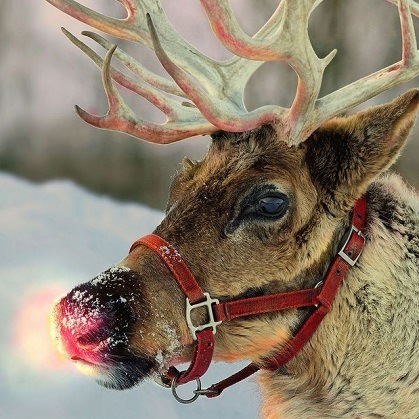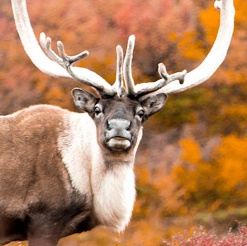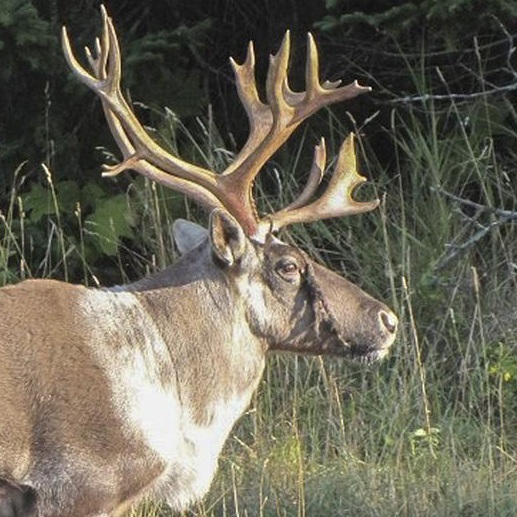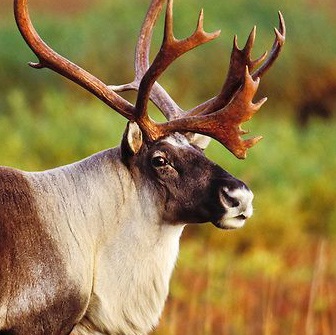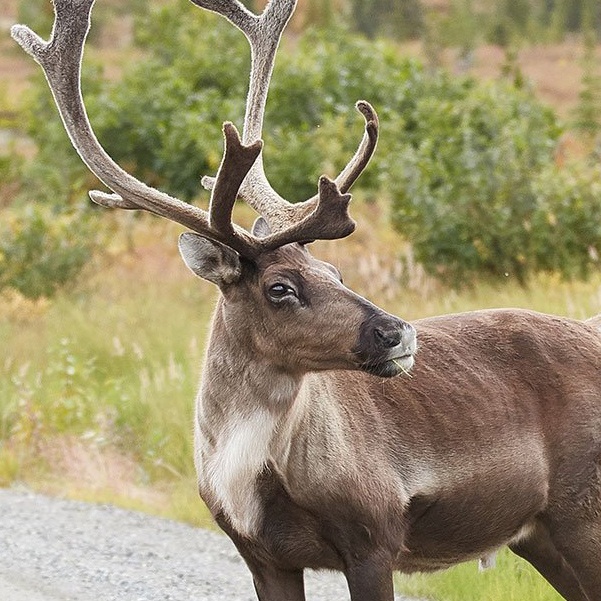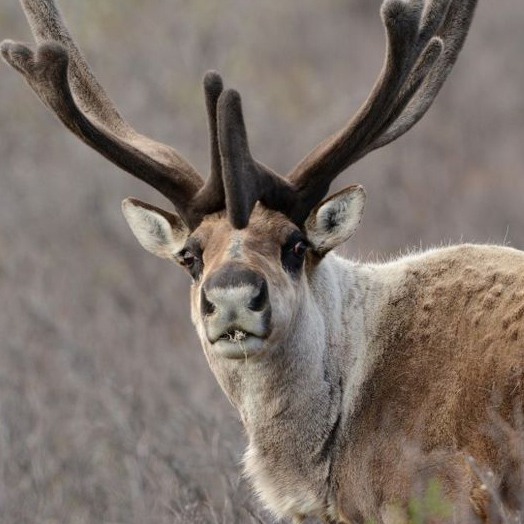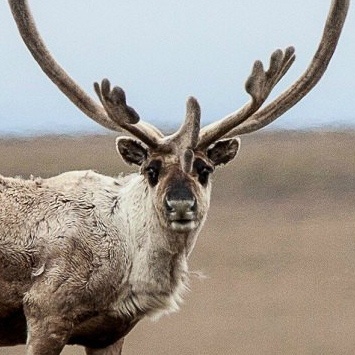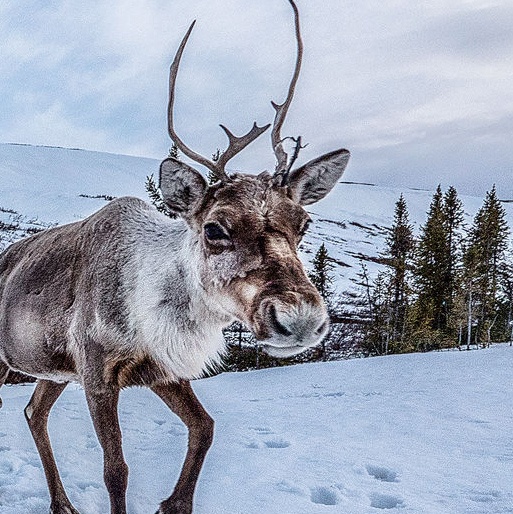Reindeer FAQ's

Santa's Magical Reindeer Team
Hey there, little friends! Do you know who helps Santa deliver gifts to all the children around the world? It's his super special team of reindeer! Let's find out how many reindeer Santa has and learn some fun things about them!
Santa's Reindeer Friends: Santa has a team of eight reindeer. Their names are Dasher, Dancer, Prancer, Vixen, Comet, Cupid, Donner, and Blitzen. They are very fast and love flying in the sky with Santa's sleigh.
Rudolph, the Red-Nosed Reindeer: There's also a very special reindeer named Rudolph. He has a shiny red nose that glows bright like a light! Rudolph helps light up the way for Santa when it's foggy or really dark outside.
All Together Now: So, if we count Rudolph too, Santa has nine reindeer in total. They all work together to make sure Santa can deliver toys and goodies to kids everywhere on Christmas Eve.
The Reindeer's Special Job: Santa's reindeer are not just any ordinary reindeer. They have magical powers that let them fly high in the sky. They are very strong and can pull Santa's sleigh all over the world in just one night!
Santa loves his reindeer team, and they love helping him! Each reindeer is important and special. Remember, it's nine reindeer in total, with Rudolph and his bright red nose leading the way. They all bring joy and happiness to children every Christmas!
Fun Facts: Reindeer love carrots, so don't forget to leave some out for them on Christmas Eve! Each of Santa's reindeer has their own special personality, just like you and your friends!
Hey there, little friends! Do you know who helps Santa deliver gifts to all the children around the world? It's his super special team of reindeer! Let's find out how many reindeer Santa has and learn some fun things about them!
Santa's Reindeer Friends: Santa has a team of eight reindeer. Their names are Dasher, Dancer, Prancer, Vixen, Comet, Cupid, Donner, and Blitzen. They are very fast and love flying in the sky with Santa's sleigh.
Rudolph, the Red-Nosed Reindeer: There's also a very special reindeer named Rudolph. He has a shiny red nose that glows bright like a light! Rudolph helps light up the way for Santa when it's foggy or really dark outside.
All Together Now: So, if we count Rudolph too, Santa has nine reindeer in total. They all work together to make sure Santa can deliver toys and goodies to kids everywhere on Christmas Eve.
The Reindeer's Special Job: Santa's reindeer are not just any ordinary reindeer. They have magical powers that let them fly high in the sky. They are very strong and can pull Santa's sleigh all over the world in just one night!
Santa loves his reindeer team, and they love helping him! Each reindeer is important and special. Remember, it's nine reindeer in total, with Rudolph and his bright red nose leading the way. They all bring joy and happiness to children every Christmas!
Fun Facts: Reindeer love carrots, so don't forget to leave some out for them on Christmas Eve! Each of Santa's reindeer has their own special personality, just like you and your friends!
Yes, reindeer are real animals! They are not just part of the Christmas stories or fairy tales. Reindeer are a type of deer that live in the cold areas of the world, like the Arctic regions of North America and Europe. In North America, they are often called caribou.
Reindeer are known for their amazing ability to travel long distances, and they are very well adapted to living in cold environments. They have thick fur to keep them warm and wide hooves that help them walk on snow and soft ground.
While the reindeer in the Santa Claus stories are magical and can fly, real reindeer obviously can't fly. But they are still very special and important animals in the places where they live. People in some cultures, especially in the Arctic, rely on reindeer for many things like transportation, clothing, and food.
Yes, female reindeer do have antlers. This is quite unique among deer species, as usually only the males have antlers. Both male and female reindeer grow antlers, and they use them for various purposes, such as defending themselves and foraging in the snow for food.
Another interesting fact about reindeer antlers is that the males typically shed their antlers in the winter, after the mating season. However, the females retain their antlers throughout the winter. This means that during the Christmas season, if we think about Santa's reindeer, they would likely all be female, since they still have their antlers at that time.
Santa’s loyal reindeer who pull his sled each Christmas are named Dasher, Dancer, Prancer, Vixen, Comet, Cupid, Donner, Blitzen, and Rudolph.
Reindeer and caribou are like cousins! They are pretty much the same kind of animal, but people call them by different names in different places. In places like Europe and Asia, people call them 'reindeer', and in places like North America, they are called 'caribou'.
Both reindeer and caribou live in cold places where there's lots of snow and ice. They have special hooves that help them walk on the snow without slipping, and they have really warm fur to keep them cozy.
Reindeer can sometimes live with people, like on farms, and people take care of them. Caribou are usually wild and like to roam around in nature.
Even though they have different names and live in different places, reindeer and caribou are part of the same big animal family. Isn't that cool?
Reindeer are really good at finding food in the snow. They love to eat something called 'reindeer moss,' which is a special kind of food that grows in their cold home. Reindeer moss isn't like the moss we see in the garden; it's a special kind that helps them stay strong and healthy.
When it's not so snowy, they munch on grass just like cows do. They also like eating leaves, small plants, and even some bushes. Sometimes, they find mushrooms in the forest and eat those too!
In the winter, when everything is covered in snow, reindeer use their strong hooves to dig through the snow. They're looking for their favorite foods hidden underneath. It's like they're playing a treasure hunt game in the snow to find their meals!"
So, reindeer are really smart and know exactly how to find their food, no matter if it's snowy or sunny outside! And of course Santa's reindeer love carrots!
Reindeer live in really cold places where there's a lot of snow and ice. You can find them near the top of the world, in places like the Arctic, which is way up north. They also live in parts of northern Europe, Asia, and North America, including countries like Norway, Russia, Canada, and Greenland.
Reindeer like these cold areas because they are very good at living in the snow. They have special fur that keeps them warm and hooves that are perfect for walking on snow and ice. They also find the food they like to eat, like reindeer moss, in these snowy places.
So, if you think of a place that's really chilly and where it snows a lot, that's where reindeer like to live!
Sprinkle this reindeer food outside at night, the moonlight will make it sparkle bright. As the reindeer fly and roam, this will guide them to your home!
Reindeer Food Ingredients:
- 1 Cup Raw Rolled Oats
- 1/2 Tablespoon Red Cookie Sprinkles
- 1/2 Tablespoon Green Cookie Sprinkles
Instructions:
- Mix all of the ingredients together.
- After you put out milk and cookies for Santa, sprinkle this mixture on your lawn. The sparkly sprinkles will shimmer in the moonlight and catch the reindeer’s attention!
Rudolph the Red-Nosed Reindeer is a special, magical reindeer, so he doesn't have an age like you and me. He was first created in a story a long time ago, in 1939, which is more than 80 years ago! But in the story, Rudolph is always young, just like in cartoons where characters stay the same age.
Rudolph is magical, so every Christmas, he's still the young, brave reindeer leading Santa's sleigh with his bright, glowing nose. He's always ready to help Santa deliver presents, no matter how many Christmases come and go!
Yes! Male reindeer have antlers that fall off and grow back larger each year. Male reindeer shed their antlers in November, and regrow them in February.
Yes, male reindeer do lose their antlers in the winter. It's like when you lose a baby tooth and a new one grows in. After the male reindeer have used their antlers in the autumn, they fall off in the winter, and then new ones start growing again for the next year. But the girl reindeer, they keep their antlers all winter long! So, during Christmas time, if you see a reindeer with antlers, it's probably a girl reindeer!
Rudolph the Red-Nosed Reindeer is like a character in your favorite storybook or cartoon. He was first thought of in a story a very, very long time ago - more than 80 years! But here's the fun part: Rudolph is magical, so he doesn't really get older like we do.
In the Christmas stories, Rudolph is always young and full of energy, ready to lead Santa's sleigh with his shiny red nose. Every Christmas, he's there, just as happy and bright as the last year. So, in a way, Rudolph is forever young because of his magic!"
This is a fun question! Usually, when we think about Santa's reindeer, we don't think about whether they are boys or girls. But there's an interesting fact about them: Most of Santa's reindeer might actually be girls!
Here's why: Reindeer are special because both the boys and girls can grow antlers. But the boys usually lose their antlers in early winter, right after the fall. The girls, however, keep their antlers all winter long. Since Santa's reindeer are always shown with their antlers on Christmas Eve, which is in the winter, they are probably girls because they still have their antlers.
So, next time you see pictures of Santa flying with his reindeer, you can think about how they might all be girl reindeer, leading the sleigh through the sky!
